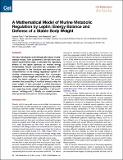A Mathematical Model of Murine Metabolic Regulation by Leptin: Energy Balance and Defense of a Stable Body Weight
Author(s)
Tam, Joshua; Fukumura, Dai; Jain, Rakesh K.
DownloadTam-2009-A Mathematical Model.pdf (872.5Kb)
PUBLISHER_POLICY
Publisher Policy
Article is made available in accordance with the publisher's policy and may be subject to US copyright law. Please refer to the publisher's site for terms of use.
Terms of use
Metadata
Show full item recordAbstract
We have developed a physiologically based mathematical model, with parameters derived from published experimental data, to simulate the regulatory effects of the leptin pathway on murine energy homeostasis. Model outcomes are consistent with data reported in the literature and reproduce key characteristics of the energy regulatory system, including compensatory responses that counteract changes in body weight and the failure of this ability when the leptin pathway is disrupted. Our model revealed the possibility of multiple steady states for body weight. It also provided a unified theoretical framework for two historically antagonistic hypotheses regarding body weight regulation (“set-point” versus “settling point”). Finally, our model has identified potential avenues for future investigations.
Date issued
2009-01Department
Harvard University--MIT Division of Health Sciences and TechnologyJournal
Cell Metabolism
Publisher
Elsevier B.V.
Citation
Tam, Joshua, Dai Fukumura, and Rakesh K. Jain. “A Mathematical Model of Murine Metabolic Regulation by Leptin: Energy Balance and Defense of a Stable Body Weight.” Cell Metabolism 9, no. 1 (January 2009): 52–63. © 2009 Elsevier Inc.
Version: Final published version
ISSN
15504131
1932-7420